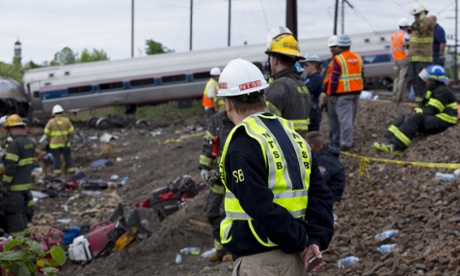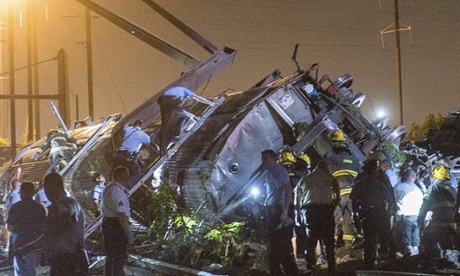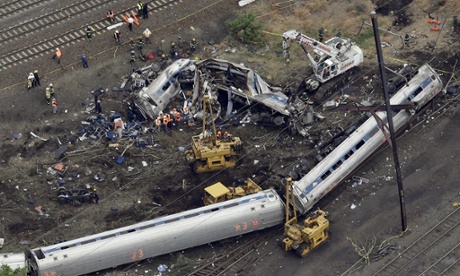A newly upgraded safety system and regulations governing track maintenance should have been enough to prevent a fatal collision between an Amtrak passenger train and a construction vehicle on Sunday.
Amtrak train 89, bound for Savannah, Georgia, from New York City, struck a backhoe just before 8am near Chester, Pennsylvania. The backhoe operator and a supervisor, both doing track maintenance work for Amtrak, were killed in the collision. Thirty-seven people on the train suffered injuries, most minor, according to local reports.
The railroad industry’s state-of-the-art safety technology – a package of communications and engineering upgrades known as positive train control (PTC) – was in place and operational at the site of the deadly crash, an Amtrak spokesman confirmed. But some actions normally expected from the system did not occur: the alerting of the train’s engineer and the automatic slowing or stopping of the locomotive.
PTC “was installed and functioning on the track and the locomotive” involved in the Sunday crash, Craig Shultz, an Amtrak senior communications officer, told the Guardian.
Light maintenance on active rail lines is not uncommon, according to Allan Zarembski, director of the railroad engineering and safety program at the University of Delaware. But, Zarembski told CNN, the presence of heavy construction equipment is.
“The fact that there was a backhoe manned by Amtrak personnel,” he said, was cause for a “higher level of concern”. Zarembski wondered if the maintenance personnel were on the wrong track, or if the work they were doing had not been properly entered into the system.
“What normally happens is the dispatcher gives the maintenance people permission to work” in a prescribed zone, he said. A dispatcher would then note it as a work area in the positive train control system, which, in turn, could alert the train.
PTC, which Amtrak once called “the most important rail safety advancement of our time”, has been the focus of much debate since a passenger train derailed last year, leaving eight dead and hundreds wounded.
On 12 May 2015, Amtrak train 188 was traveling more than twice the posted speed limit when it entered a tight curve just north of Philadelphia. Had PTC been operational that night on that section of track, the engineer would have been alerted of the unsafe speed and the train would have automatically slowed, probably preventing the derailment.
The Rail Safety Improvement Act of 2008 (passed soon after a train-on-train collision in Chatsworth, California, killed 25) originally mandated the installation of PTC systems on all US railways by the end of last year. But that deadline was pushed back three to five years by language inserted into the 2015 transportation bill.
The Federal Railroad Administration (FRA) urged the nation’s carriers to move more quickly. And just before Christmas, Amtrak completed activation of its PTC system on all the parts of the North-east Corridor it owned.
The focus of most debates over positive train control has been on derailments caused by excessive speed, accidents due to misaligned switches and train-on-train collisions. But the system, which relies on sensors on the tracks and in the locomotives, can also be set to prevent trains from entering established work zones, such as areas where maintenance teams are on the tracks.
Positive train control could also aid in communicating train location and speed to maintenance teams that might be near active rail lines.
Amtrak’s Schulz said the railroad could not comment on whether its PTC system could detect heavy equipment, such as a backhoe, on the tracks, citing an ongoing investigation by the National Transportation Safety Board. Schulz also declined to say if Amtrak’s system could communicate a track blockage to an approaching locomotive, to either alert the engineer or automatically stop the train.
“Investigators have examined the locomotive and passenger cars. The examination included the collection and inspection of maintenance records. At this time, no anomalies have been found,” said the NTSB’s Ryan Frigo during a Monday briefing.
FRA rules require all maintenance workers to be notified if track restrictions have changed, and limits on train access are not supposed to be lifted until all workers have left the tracks or been sufficiently warned of a train’s approach.
In a statement, Amtrak noted that it has “strict protocols that crews must follow when tracks are taken out of service for maintenance or when work is being performed along the right-of-way”. The railroad added that it was working with the NTSB to “identify the issues that led to this incident”.
But with equipment failures thus far ruled out by the NTSB, attention turns to the possibility of human error, either on the part of train dispatchers or the maintenance crew.
One federal official, who could not speak on the record because of the ongoing investigation, compared the PTC system to a clock radio, noting that if the user doesn’t set a wakeup time, the clock won’t know when to sound the alarm.
Conversely, said Zarembski, if PTC is set up for one work zone, but track workers go to another, “there’s no way of knowing that” under the current system.
Sunday’s fatalities were the second and third for workers on Amtrak’s North-east Corridor in just the last five weeks, according to the Brotherhood of Maintenance of Way Employees, a union that represents track workers. After a death in early March, Amtrak said it enhanced its safety protocols to include a “zero-tolerance” policy for violations.










